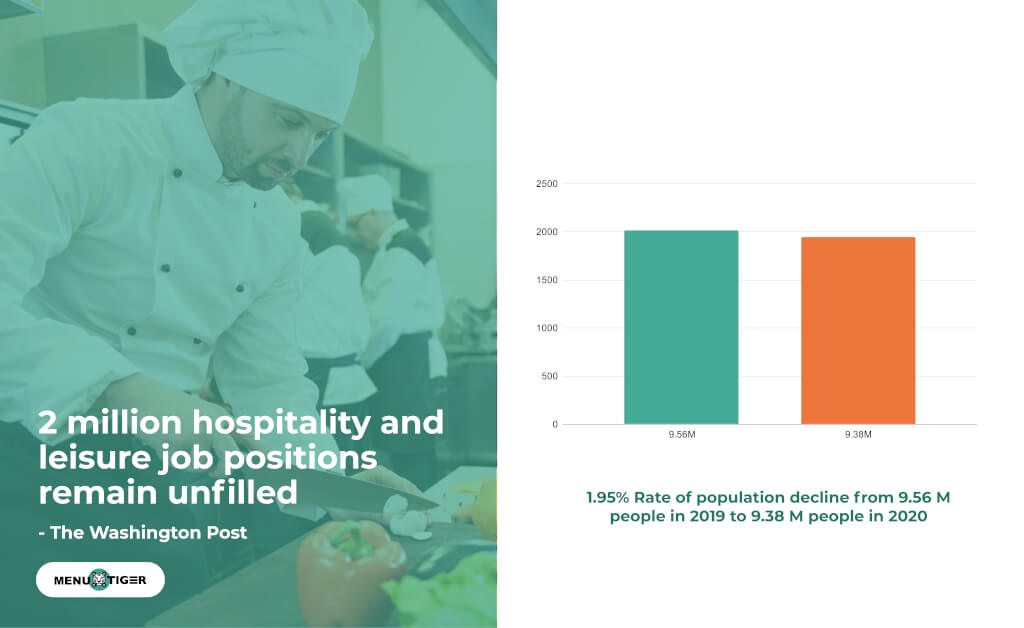
Restaurant Employment Statistics: Labor Shortages Turnover Rate
Last Updated: April 19, 2024
Want to know the latest restaurant employment statistics? You’ve come to the right place.
This relevant data includes the employee demographics, average income, restaurant turnover rate, and why they quit their food service industry jobs.
Knowing and understanding the employees' demands and concerns is essential to establish a friendly, stress-free work environment. It’s also great to apply the latest industry strategies to your establishment.
For instance, integrating QR code menu software will significantly aid in retaining employees as it reduces their time and effort in completing certain tasks.
This technology automates the manual process of taking customers' orders, processing payments, and even generating tips—which is a big advantage for the staff.
Let's dive into the most crucial part: knowing the essential restaurant employment data and learning more about this technology.
Restaurant employment statistics: Employees' demographics and income

As of 2022, the United States has approximately 14.9 million restaurant employees, including the following: food service managers, supervisors, chefs, cooks, waitstaff, bartenders, food preparation staff, and counter workers.
According to a survey conducted in January 2022, servers at full-service restaurants earn a median of $27.00 an hour.
Meanwhile, those in fine dining establishments earn a median hourly wage of $36.48 ($29.50 in tips plus $6.98 in employer-paid salaries).
The food and beverage sector is the largest segment of the hospitality industry, composed of diverse employees with different backgrounds.
Here are some employment-related restaurant statistics by the National Restaurant Association, based on the 2019 data from the U.S. Census Bureau’s American Community Survey (ACS):
- 70% of waitstaff and 58% of bartenders are female.
- 1 in 5 chefs and 1 in 3 cooks are female.
- 37% of restaurant and food service workers are under 25, and 60% are under 35.
- Managers (15%) and chefs (14%) have the highest representation among adults 55 and older.
- Food preparation and counter workers (75%) and waitstaff (70%) are the most likely to be single.
- The marriage rate is highest among chefs (47%) and managers (44%).
- 10% of bartenders and 8% of waitstaff over 23 are enrolled in school.
Restaurant statistics on labor shortage: restaurant positions remain unfilled
The ACS found that the food and beverage industry saw a 1.95% decline in the restaurant industry employment rate, from 9.56 million in 2019 to 9.38 million in 2020.

The increasing turnover rate became evident when the pandemic struck. Many restaurant employees took the risk of changing careers while older ones retired.
This left restaurants no choice but to let go of employees and, in worse cases, shut down their business.
According to the National Restaurant Association, the average number of employees in a restaurant is 50 in 9 out of 10 dining establishments.
Today, the aftermath of the pandemic shows how the food dining sector still struggles to fill the 2 million vacancies in hospitality and leisure, The Washington Post reports.
Restaurant industry employment statistics: Reasons why employees are leaving their service industry jobs
Here are the main reasons for the high restaurant turnover rate:
Unclear job expectations
Employees who do not know what they will or should be doing at work become unhappy; for some, this loss of direction becomes a source of stress.
They'll likely look for a more fulfilling job if their present tasks do not match their job description—the things they should be doing.
To prevent this unfavorable circumstance, you must discuss clear job expectations during the recruitment. You have to be upfront about the positives and negatives of the job.
This way, employees will clearly understand the tasks they need to accomplish.
Lack of advancement
The lack of workforce can compromise your overall customer service, contributing to the industry's inclining restaurant failure rate statistics.
However, employing technology like QR code menu software can help you alleviate this problem, helping you stay productive without hiring more employees.
This will significantly address common back-of-house operations, such as lack of staff and inaccurate orders, as it automates services.
This can save servers time receiving customer orders and manually processing their bills.

Being overworked
When employees are overwhelmed with numerous assignments and consistently face stress, this will likely add to the causes of burnout.
Professional services firm Deloitte states that the primary driver of employee burnout is the lack of support or recognition from leadership, which only emphasizes the crucial role of leaders at work.
The survey found that almost half of millennials say they have quit their job because they felt burned out, compared to 42 percent of all respondents.
That’s why managers must promote communication among employees and allow them to talk openly, giving them a chance to air their concerns. Empathy and understanding towards employees will be the key to solving their issues.
Hours and Pay
Another contributing factor to high turnover is issues with hours and pay. Employees who receive more hours without any increase in their pay can become dissatisfied.
On the other hand, an employee who only has a few hours will be urged to seek another job that will give them sufficient income.
Moreover, an employee's wage is crucial since it will impact their decision to stay. A study by HR solutions provider Paychex revealed the restaurant industry employment rate that 70% of employees would quit because of low compensation.
To be fair, starting pay for new employees is typically low, but if they don't earn enough, there's a high probability that they’ll look for another job opportunity that sustains their needs.
How can a QR code menu help retain restaurant employees?
The popularity of digital menus continues to soar, even post-pandemic. This left a remarkable impact not only on restaurant operators but also on customers.

MENU TIGER’s restaurant industry statistics show that the USA is the leading user of the interactive digital restaurant menu software.
According to the National Restaurant Association, half of all full-service restaurant owners in the United States have incorporated menu QR codes since the beginning of the pandemic.
Bitly president Raleigh Harbour stated that restaurants had realized the value of QR technology, which goes beyond facilitating touchless services. This explains why QR codes in restaurants are still present today.
Here are the different ways that digital menus can help restaurant workers:
Generate tips online to motivate employees
Tipping is a way for the guest to show satisfaction and reward employees for excellent service. Receiving tips from guests can boost employees' morale, driving them to do better in the future.
According to a study, tips can be a motivational element that can help retain waitstaff—crucial for the success of any business—and prevent the high expenses associated with turnover.
MENU TIGER can generate tips online. Diners can freely give any tip amount as they pay for their meal through banking apps or mobile wallets.
This innovation provides convenience for diners since they can pay and tip in one transaction using their smartphone.
Take customers’ orders and payments online
Taking customers’ orders and payments manually is a tiresome in-house operation prone to errors. This task can be frustrating on the staff’s end, especially during peak hours.
But when you incorporate a QR code based restaurant menu, such as MENU TIGER, it’s easier to get customers' orders as it facilitates mobile ordering through QR codes.
And in terms of payment, it supports online payment through various electronic payment channels such as PayPal, Stripe, Google Pay, and Apple Pay—a hassle-free method for customers and staff.
A 2021 survey found that four in five Americans used digital payment methods, which suggests more customers prefer to pay cashless. This only means that an efficient menu software that accepts online payments would favor your business.
QR code technology can facilitate a more convenient dining experience for customers and a smoother workflow for employees since they won’t have to worry about committing errors regarding customer orders and check sizes.
Translate a QR code menu into multiple languages
Communicating with a foreign customer can be a lot of work, particularly for those employees who do not speak their language.
However, incorporating a digital menu in your establishment will help because this technology supports multi-language translation features.
Diners can select a copy of the menu in their preferred language, eliminating the need for waitstaff to explain and respond to customer inquiries in a language they don’t know.

Retain employees at your restaurant with QR code technology
Restaurant employment statistics is an integral element that restaurateurs must consider to make informed decisions about the next steps toward business growth.
Knowing this will help you meet employee needs and create strategies to retain them—helping you save on high turnover costs.
Start building a better workplace for employees by integrating restaurant management tools like an interactive QR code menu software by MENU TIGER. This digital tool can help retain workers and boost productivity, leading to better customer service.
Subscribe to MENU TIGER’s freemium plan or start a free trial on its affordable plans.


